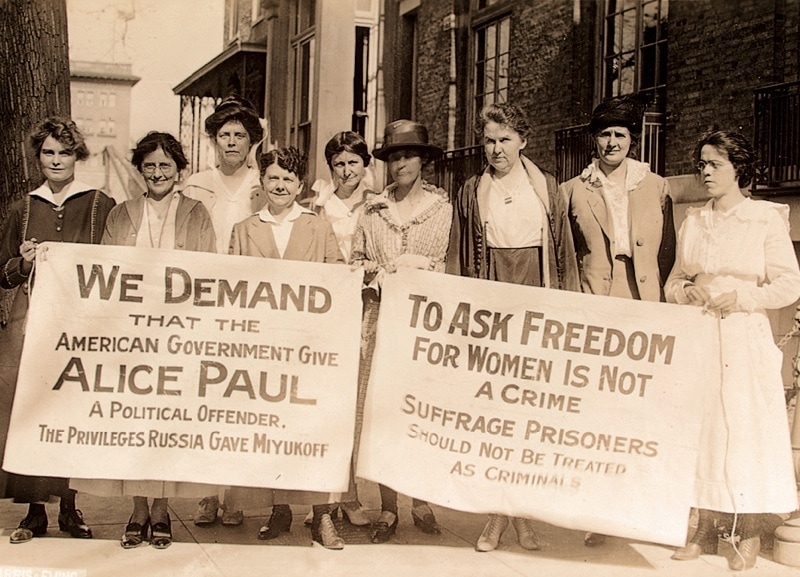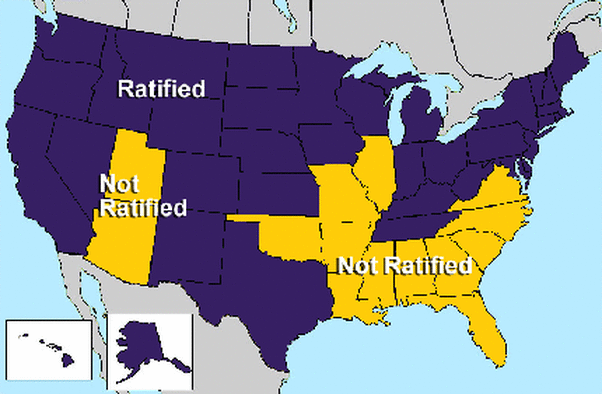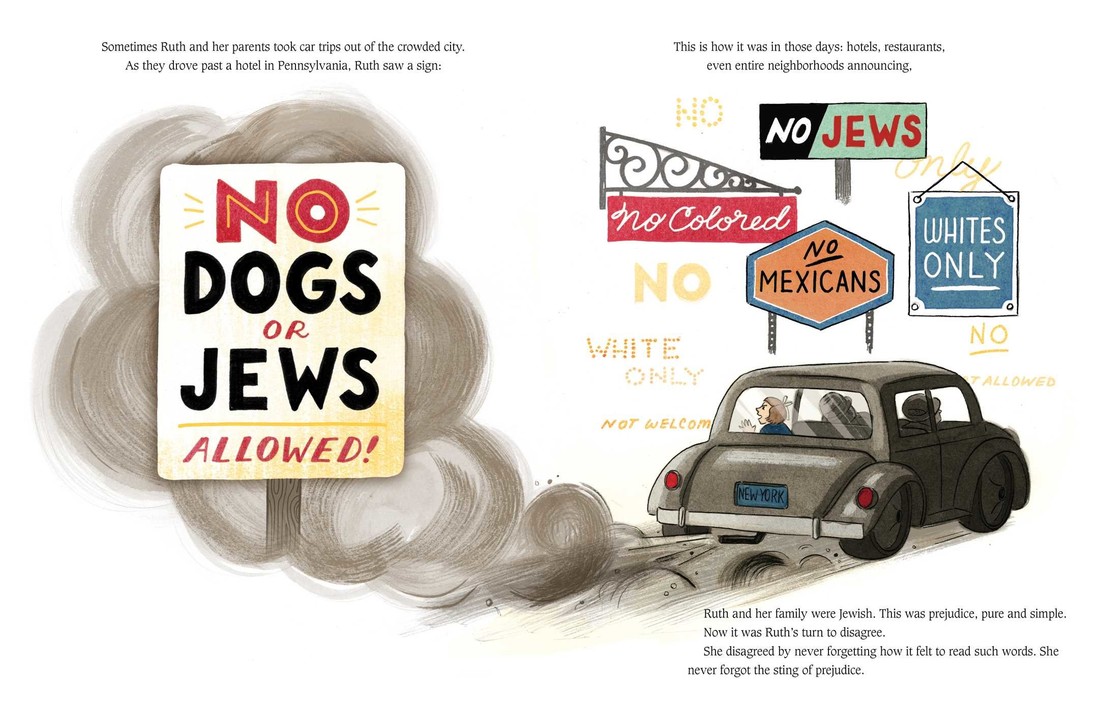|
Imagine devoting your entire adult life to a cause, living more than 90-years, and dying with unfinished business. Alice Paul believed that men and women should be equal partners in society, and she was behind most 20th Century efforts for women's rights in the United States, including women's right to vote. Now, close to 100 years after Alice Paul started the fight for an Equal Rights Amendment, women in the U.S. are still second class citizens under the law. (See video below) 
In October 1917, Alice Paul and three other suffragists were arrested for protesting at the west gate of the White House. She did not go quietly, believing that equal rights for women would not be gained without extreme measures.
Confined behind bars, her only power was refusing to eat. She had resorted to hunger strikes before when arrested in England. When the forcible feeding was ordered I was taken from my bed, carried to another room and forced into a chair, bound with sheets and sat upon bodily by a fat murderer, whose duty it was to keep me still. Then the prison doctor, assisted by two woman attendants, placed a rubber tube up my nostrils and pumped liquid food through it into the stomach. Twice a day for a month, from November 1 to December 1, this was done. ~Alice Paul Talks, Philadelphia Tribune, January 1910. 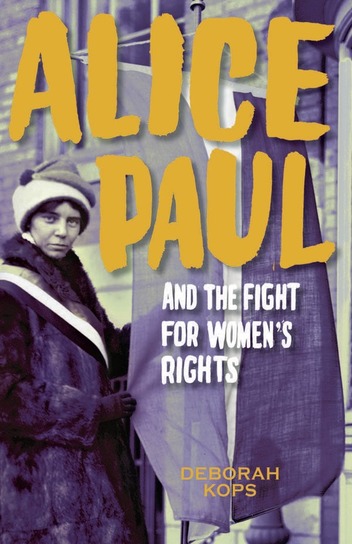
A new biography of Alice Paul brings the story of this less-well-known suffragist to teenagers in ALICE PAUL AND THE FIGHT FOR WOMEN'S RIGHTS.
Author Deborah Kops agreed to talk with me about Alice's passion and determination. Deborah Kops: I am awed by Paul’s courage and her willingness to risk her life to help women win the vote. Her health was fragile, and she jeopardized it on a regular basis when she was young. Paul went on her longest hunger strike, which lasted three weeks, in 1917, when she was in jail in Washington, D.C. (she went on three hunger strikes years before in the UK). For most of that time, she was force fed, which is very painful. A hunger strike was her only means of fighting her imprisonment and reminding the public that women wanted the ballot. She and the other Woman’s Party members who went without food (more than twenty) got plenty of coverage in newspapers around the country, which embarrassed Woodrow Wilson. Less than two months after Paul’s release, Wilson finally announced his support for the woman suffrage amendment. The amendment was ratified August 18, 1920.
Above: Fellow Suffragists protesting Alice Paul's arrest and incarceration for picketing the White House. Photo courtesy of the Historic National Women's Party, Sewell-Belmont House and Museum, Washington D.C. 
Deborah, this book seems personal to you. (Author pictured below)
I became a feminist during the women’s movement of the late sixties and early seventies, which historians call the second wave. And I assumed that the Equal Rights Amendment, which we were fighting for, was written in the sixties. I learned that the amendment was Alice Paul’s idea and that she wrote it in 1923! A century later, when Hillary Clinton made her acceptance speech as the first woman nominated by a major political party for the presidency, I was very touched to see her wearing white, the color that suffragists often wore beneath their sashes. When I joined the Women’s March in Boston in January, I was very proud to wear a sash with the National Woman’s Party colors—purple, white, and gold—over my jacket. Thank you for taking time for this interview, Deborah, and for writing about this courageous woman! You can see all of Deborah Kops books at her website here, including The Great Molasses Flood: Boston, 1919 which Kirkus Reviews calls A fascinating account of a truly bizarre disaster. Back to the Equal Rights Amendment. If you know anyone living in the states colored yellow below...ask them if they know their state has not ratified the ERA. Then check out the video below (it's less than two minutes long). Feel free to forward this newsletter. Thanks www.equalrightsamendment.org for the map. Just three weeks ago Nevada became the 36th state to ratify the ERA (45 years to the day after Congress passed it). This year ERA bills have been introduced in the legislatures of Arizona, Florida, Illinois, North Carolina, Utah, and Virginia. 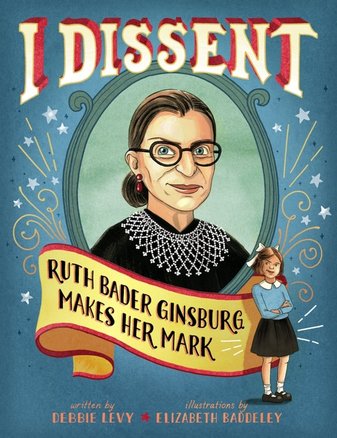 I wish I'd learned as a kid, how to get along with and respect people I disagree with. Maybe then it would be easier now. Those early lessons become second nature and we barely think about them. This book is a great story to read with kids and open up the conversation about being friends with people even when your ideas are polar opposites. I Dissent: Ruth Bader Ginsburg Makes Her Mark, by Debbie Levy has a list of tributes and prizes as long as my arm. It's a Booklist Editors’ Choice, NCTE Orbis Pictus honor book, on the New York Public Library Best Books for Kids, and more. I'm in awe of how the author put so much information into forty illustrated pages, included humor, making Ruth so human, and tying it all together seamlessly. The process of writing a beautiful, succinct, powerful picture book is hidden. It appears effortless. It's not. Believe me. I've tried it.  Author Debbie Levy Author Debbie Levy Author Debbie Levy kindly agreed to an interview, and I asked her to share some part, perhaps a crucial step in the process of how she distilled the story of Ruth Bader Ginsburg becoming a Supreme Court Justice in a way that would interest kids. Debbie Levy: Early on in my research, I realized my theme: that Ruth Bader Ginsburg’s life has been one disagreement after another. I found that she’d been disagreeing with unfairness and discrimination and injustice from the time she was a young girl. So this theme—that disagreeing doesn’t make you disagreeable and that important change can happen one disagreement after another—was the crucial step in the process of writing this book. (Below: Pages from I DISSENT) “Ruth objected” (also in school, to the rule that required girls to take home ec, reserving shop class for boys). 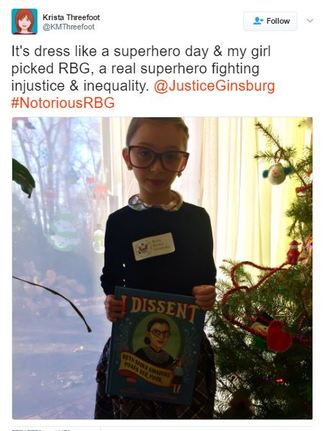 Courtesy Twitter Courtesy Twitter Debbie Levy: There is a variation on the “I dissent” theme on nearly every spread in the book. “She protested” (as a schoolgirl, to being required to write with her right hand even though she is left-handed). “Ruth disapproved right back” (when people disapproved of her decision to go to law school). “She resisted. And persisted” (when, as a young law school graduate at the top of her class, no one would hire her because she was a woman, a mother, and a Jew). And so on. The tone is enhanced—and I love this—by Elizabeth Baddeley’s large and emphatic hand lettering of these “dissenting” refrains. Mary: One of the most powerful parts of the book for me comes near the end, when the character some might call Ruth's nemesis comes into the story. The illustration shows RBG arguing with Supreme Court Justice Antonin Scalia.
Then on the next page the two justices are parasailing together in France, then riding an elephant like BFF in India. That inspires me. And challenges me. How can we get along better with people we disagree with? Debbie Levy: One lesson is to listen: to listen, really listen, to what people on the other side of an argument have to say. Before his death last year, Justice Scalia was the Supreme Court justice with whom RBG most frequently, and deeply, disagreed. But they neither shouted past each other nor ignored each other. Instead, they shared their conflicting ideas. They pointed out weaknesses in the other’s arguments. Justice Ginsburg has explained how this helped her: “Justice Scalia nailed all the weak spots—the ‘applesauce’ and ‘argle bargle’—and gave me just what I needed to strengthen . . . [my] opinion.” The takeaway here: take advantage of a good adversary’s critique. Thank you, Debbie, I appreciate you taking the time to talk with us. Congratulations on an outstanding book! Check out all Debbie's books here... |
I'm fascinated to discover little-known history, stories of people and events that provide a new perspective on why and how things happened, new voices that haven't been heard, insight into how the past brought us here today, and how it might guide us to a better future.
I also post here about my books and feature other authors and their books on compelling and important historical topics. Occasionally, I share what makes me happy, pictures of my garden, recipes I've made, events I've attended, people I've met. I'm always happy to hear from readers in the blog comments, by email or social media. Archives
September 2023
Categories
All
|
